Cornish Rex Cats: A Guide to Their Curly Coats and Care
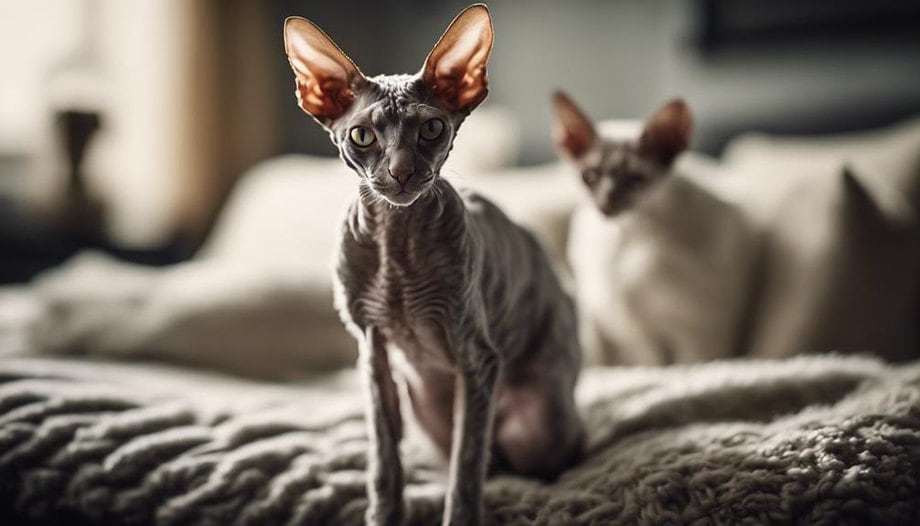
Cornish Rex Cats: Caring for Their Curly Coats and Playful Personalities.
Essential tips for grooming, health, and diet to keep your Cornish Rex happy and healthy.
Breed Overview
The Breed Overview of Cornish Rex cats showcases their distinctive genetic origin, unique physical characteristics, and engaging personality traits. Originating in England in the 1950s from a genetic mutation, Cornish Rex cats stand out due to their curly coat, which sets them apart from other breeds. This mutation affects the structure of their fur, giving it a soft, wavy appearance that feels like plush velvet to the touch. In addition to their curly coat, these cats have a svelte physique, large bat-like ears, and an egg-shaped head, making them easily recognizable.
Beyond their physical attributes, Cornish Rex cats are known for their sociable personality traits. They're highly interactive, playful, and affectionate companions, often forming strong bonds with their human family members. Their love for family interaction and their tendency to exhibit vocal communication due to their Siamese heritage make them engaging and delightful pets to have around.
Characteristics
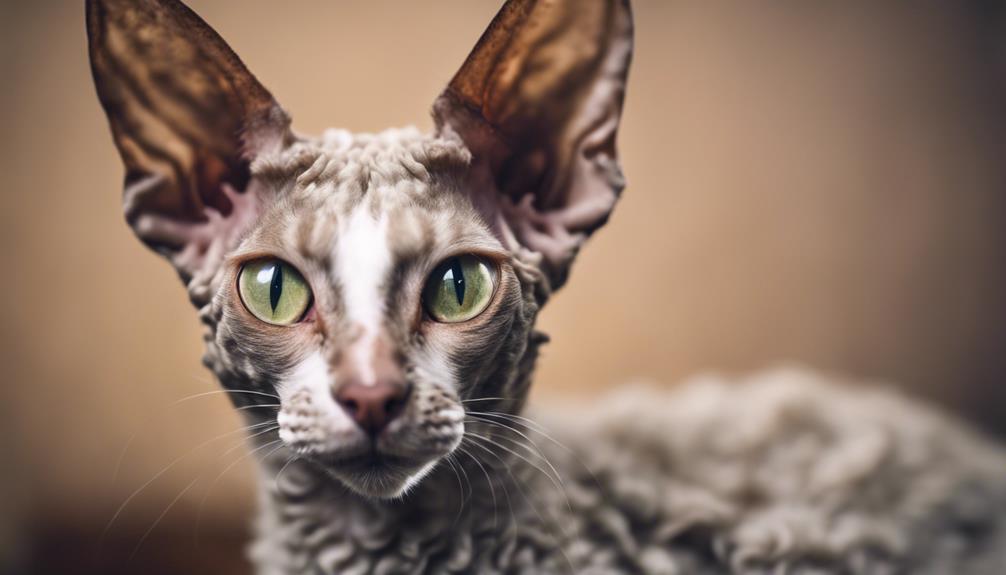
Characterized by a svelte physique, unusually arched back, and long limbs, Cornish Rex cats exhibit distinctive physical features that set them apart from other breeds. Their genetic makeup gives them a unique curly coat that's soft to the touch and lacks the typical guard hairs found in most cat breeds. These cats come in various coat colors, including black, blue, lilac, brown, chocolate, red, cream, and smoke, adding to their individual charm. With a typical weight of up to 10 pounds and a length of 18 inches, Cornish Rex cats are elegant and graceful creatures.
Aside from their striking appearance, Cornish Rex cats are beloved for their playful nature and affectionate personality. They thrive on interactive playtime with their human companions and enjoy being the center of attention. Vocal communicators, they'll often express themselves through a range of meows and purrs, making them engaging members of the Cat Breeds community.
Grooming Tips
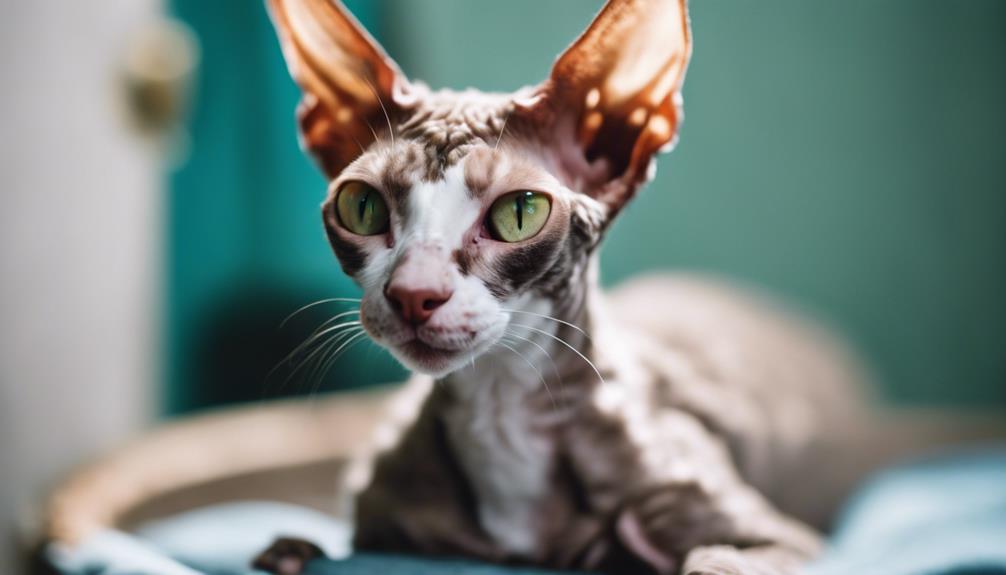
Cornish Rex cats require specific grooming techniques to maintain their unique curly coat. Brushing for shedding control, bathing frequency, and product selection are key aspects of their grooming routine.
Nail trimming is also important. It's essential to handle their grooming with care and attention to preserve the health and appearance of their distinctive coat.
Brushing for Shedding Control
Regularly grooming a Cornish Rex involves gentle brushing techniques to control shedding and prevent matting. When brushing your Cornish Rex, consider the following tips:
- Use a soft brush or a grooming glove to gently remove loose fur from their unique curly coat.
- Regular brushing can distribute natural oils, keeping the coat healthy and shiny.
- Focus on areas like the underarms, belly, and tail where matting is more likely to occur.
- Avoid over-brushing to prevent damage to the delicate curly hairs of the Cornish Rex.
Bathing Frequency and Products
To maintain the cleanliness and health of a Cornish Rex cat's unique curly coat, bathing frequency and the use of appropriate grooming products are essential aspects of their care routine. Cornish Rex cats generally do not require frequent baths due to their minimal shedding and self-grooming habits. Bathing every 2-3 months or as needed for soiling or skin issues is sufficient. When bathing your Cornish Rex, it is crucial to use a mild, cat-specific shampoo to avoid stripping their skin of natural oils. Regular grooming and wiping with a damp cloth can help keep their coat clean between baths. It is advisable to consult your veterinarian for specific recommendations on bathing frequency and products suitable for your Cornish Rex cat's skin and coat type.
| Bathing Frequency | Cat-Specific Shampoo | Veterinarian Recommendations |
|---|---|---|
| Every 2-3 months or as needed | Use a mild, cat-specific shampoo | Consult your vet for specific advice |
Nail Trimming Techniques
When trimming a Cornish Rex cat's nails, it's important to use cat-specific nail clippers or scissors and maintain them at a 45-degree angle for optimal grooming. To make the process easier, keep styptic powder on hand to help stop bleeding if a nail is accidentally clipped too short. Remember to trim the sharp tip of the nail while avoiding the quick, which is the blood vessel inside the nail.
Starting nail trimming training early can accustom your Cornish Rex to the process, making it less stressful for both of you. Regular nail trims are essential to prevent painful overgrowth, snagging, or accidental scratches.
- Use cat-specific nail clippers or scissors
- Keep styptic powder on hand
- Trim the sharp tip, avoiding the quick
- Start trimming training early
- Maintain regular nail trims
Exercise Needs
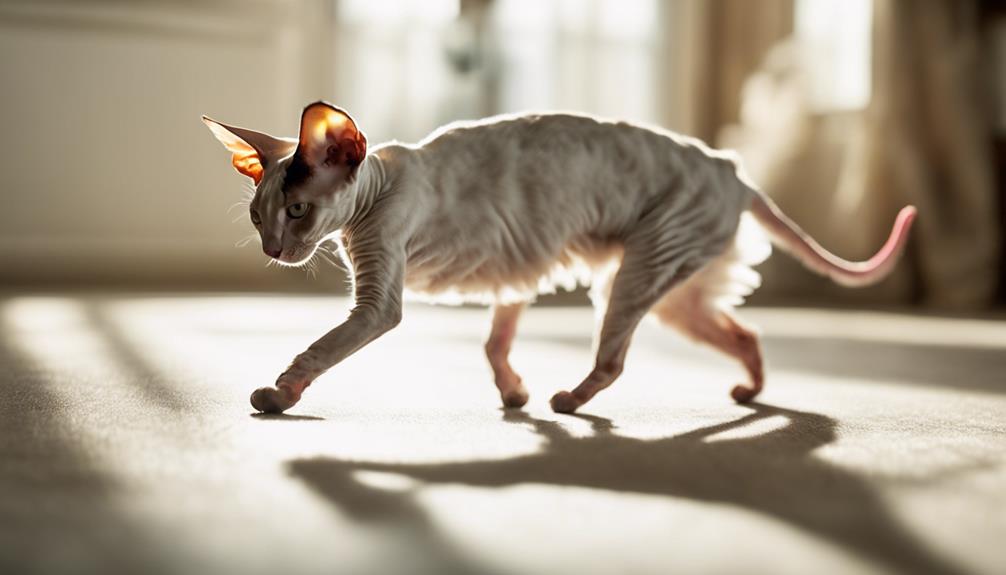
Cornish Rex cats exhibit a strong need for regular exercise, requiring interactive play sessions to maintain their mental and physical well-being. These cats thrive on exploration and climbing, making cat trees, window perches, and interactive toys essential for their well-rounded development. Engaging in interactive play not only provides them with the necessary physical activity but also offers mental stimulation crucial for their overall health.
Common Health Issues
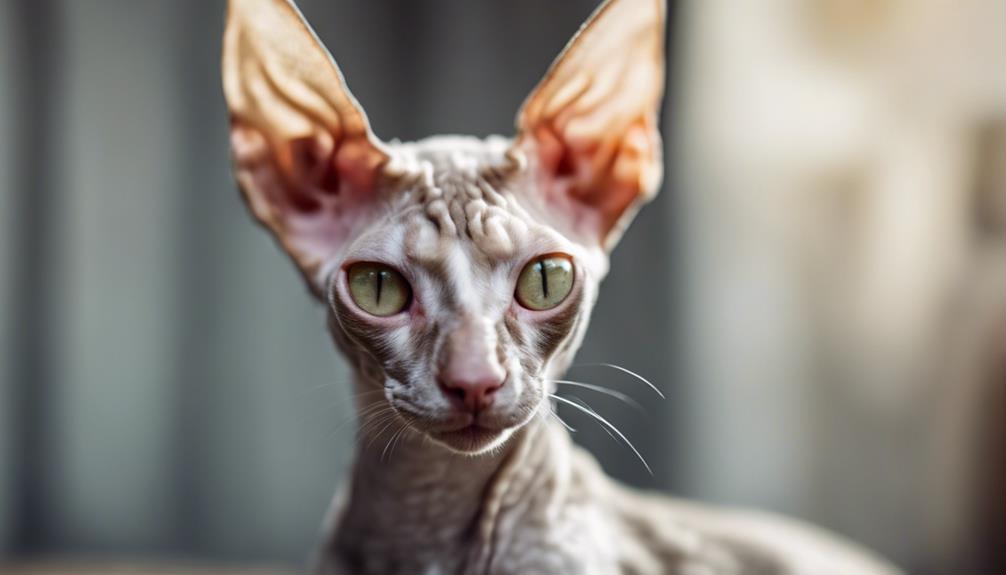
Common health issues in Cornish Rex cats may include susceptibility to congenital hypotrichosis, requiring special attention to their unique coat and skin care. This breed's genetic heritage contributes to their overall health, making them less prone to diseases commonly found in other purebred cats. Despite some health concerns such as skin issues, Cornish Rex cats generally benefit from a diverse genetic background, leading to healthier lives. It's important for owners to be aware of potential health issues to provide the best care for their feline companions.
- Cornish Rex cats may be susceptible to congenital hypotrichosis, a condition that can cause thinning of their fur.
- Skin care may be necessary for Cornish Rex cats to prevent dryness or sunburn due to their unique coat.
- The breed isn't particularly prone to diseases commonly found in other purebred cats, contributing to their overall health.
- Cornish Rex cats have a long lifespan, often living into their late teens and some even surpassing 20 years.
- While they may have some health concerns such as skin issues, overall, Cornish Rex cats benefit from a diverse genetic heritage leading to healthier lives.
Dietary Requirements

Cornish Rex cats have specific dietary requirements that prioritize high-protein meals to support their unique physique and energy levels.
Providing a well-balanced diet with quality cat food is essential for maintaining the overall health and well-being of these cats.
Scheduled meals and occasional treats of fruits and vegetables are key components of a Cornish Rex cat's diet, with guidance from a veterinarian crucial for establishing a suitable feeding routine.
Nutritional Needs Overview
High-protein diets are essential for supporting the muscular appearance and active lifestyle of Cornish Rex cats. To ensure optimal health and well-being for these unique felines, a balanced diet is crucial. Veterinary consultation is recommended to tailor the feeding routine and dietary choices to the individual cat.
Cornish Rex cats thrive on diets rich in protein to maintain their lean muscle mass and energy levels. Here are some key points to consider regarding the nutritional needs of Cornish Rex cats:
- High-protein cat food is vital for muscle support.
- A balanced diet is crucial for overall health.
- Consulting a veterinarian helps determine the best diet.
- Protein-rich diets sustain the active lifestyle.
- Optimal nutrition enhances the cat's well-being.
Feeding Guidelines for Health
To support the optimal health and well-being of Cornish Rex cats, it is essential to adhere to specific feeding guidelines that cater to their unique dietary requirements. Cornish Rex cats require a high-protein diet to maintain their muscular build and active nature. Providing balanced meals is crucial in preventing obesity, considering these cats have hearty appetites. Scheduled feeding helps manage their weight, as they are prone to obesity if overfed. Occasionally giving treats of fruits and vegetables can complement their diet. Consulting with a veterinarian for personalized feeding routines and dietary choices is recommended to ensure the best health outcomes for Cornish Rex cats.
| Feeding Guidelines | Description | Importance |
|---|---|---|
| High-Protein Diet | Supports muscular build and activity levels in Cornish Rex cats. | Essential for health. |
| Balanced Meals | Prevents obesity and ensures overall well-being of the feline. | Crucial for weight management. |
| Scheduled Feeding | Helps regulate weight and prevents overeating, common in this breed. | Key in obesity prevention. |
Adoption and Purchase Options
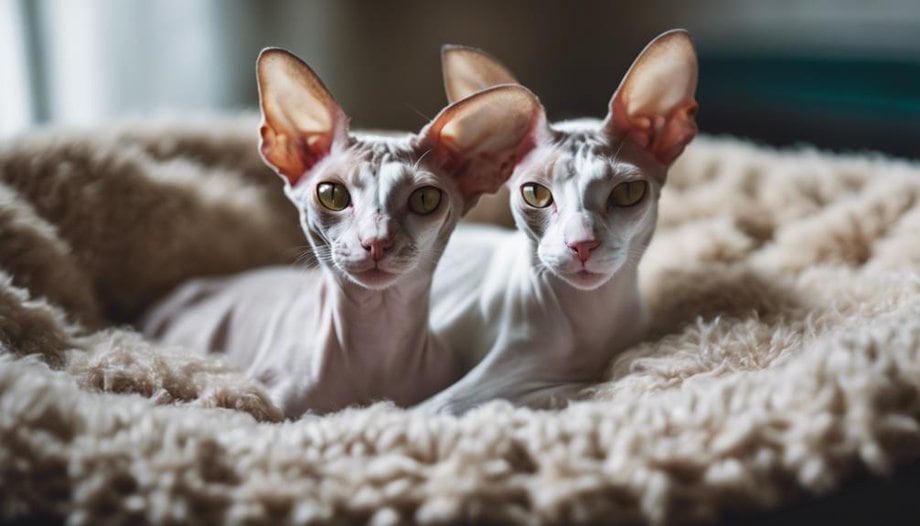
When considering adoption or purchase options for a Cornish Rex cat, potential owners should explore reputable breeders, rescue groups, and breed clubs as valuable resources. The Cornish Rex breed stands out for its unique characteristics, making it essential to understand their specific needs before bringing one home. Here are some key points to consider:
- Adoption fees for Cornish Rex cats typically range from $800 to $1,200, reflecting the breed's unique characteristics and popularity.
- Reputable breeders, rescue groups, and breed clubs are excellent resources for adopting or purchasing a Cornish Rex cat.
- Unwanted Cornish Rex cats are often re-homed through breeder networks, as their distinctive appearance makes them rare in shelters.
- Potential adopters should consider the specific needs and characteristics of the Cornish Rex breed before making a decision.
- Quality breeders and organizations provide valuable insights and guidance to ensure a suitable match between the cat and its new home.
Frequently Asked Questions
Are Cornish Rex Cats High Maintenance?
When it comes to grooming needs and shedding habits, Cornish Rex cats are not high maintenance. They require minimal care due to their low shedding nature. Regular nail trimming and dental care are essential.
Do Cornish Rex Like to Cuddle?
Cornish Rex cats adore cuddling, seeking closeness with their owners. They enjoy playtime, cozy spots, and bedtime snuggles. Their affectionate nature makes them delightful lap companions, valuing warmth, physical contact, and interactive toys.
How Often Do You Bathe a Cornish Rex?
When caring for a Cornish Rex, it's vital to establish a grooming routine that strikes the right balance. Bathing frequency varies, but every 1-2 months with a gentle cat shampoo is recommended. Regular coat care ensures hygiene and comfort.
How Do You Take Care of a Cornish Rex Cat?
To take care of a Cornish Rex cat, one should provide interactive play, monitor diet, groom regularly, and ensure access to climbing structures. This promotes exercise, mental stimulation, and overall well-being, keeping the cat healthy and happy.











